|
|
|
Sort Order |
|
|
|
Items / Page
|
|
|
|
|
|
|
| Srl | Item |
| 1 |
ID:
125928
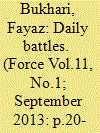

|
|
|
|
|
| Publication |
2013.
|
| Summary/Abstract |
After a decade of peace, the Line of Control (LC) in Poonch sector is hot again following the killing of five soldiers by Border Action Team (BAT) of Pakistan army at Khari Karmara village in Poonch sector on August 6. This was the second BAT action in Poonch sector this year. Earlier, two soldiers were beheaded early January. The intense LC firing started three days after the BAT action only after the army got a go ahead for a befitting reply to Pakistani ceasefire violations in the sector.
|
|
|
|
|
|
|
|
|
|
|
|
|
|
|
|
| 2 |
ID:
125365
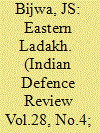

|
|
|
|
|
| Publication |
2013.
|
| Summary/Abstract |
The Armed Forces are India's "hard-power" assets and not a tool for diplomacy on the borders. Deployment of an armed force to support a diplomatic effort is axiomatic as it lends strength to diplomacy. Should "soft power" of diplomacy fail, then the will to suitably demonstrate use of "hard power" must not be found wanting. India is a Nation tugging at its leash to surge forward in all arenas of development. Without throwing caution to winds, there is a requirement to be less tentative and more assertive. India's national interests must be paramount. At stake here are the aspirations of a young generation for a bright progressive future.
"Perform necessary action; it is more powerful than inaction; without action, you even fail to sustain your own body." -Mahabharata
|
|
|
|
|
|
|
|
|
|
|
|
|
|
|
|
| 3 |
ID:
132260
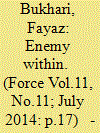

|
|
|
|
|
| Publication |
2014.
|
| Summary/Abstract |
This year the Indian Army achieved a major success by killing 41 militants including 11 top commanders of Lashkar-e-Toiba (LeT), Jaish-e-Mohammad (JeM) and Hizbul Mujahideen (HM) and arrested 23 of them in joint operations with the police.
The figures reveal that this is more than the number of militants neutralised last year, but over the years killing of militants is not making much of a difference as new recruits replace them.
Lieutenant General Subrata Saha, who took over as the General Officer Commanding (GOC) of Army's strategic Chinar Corps or 15 Corps, responsible for tackling militancy in Kashmir besides guarding the Line of Control (LC), has a bigger challenge ahead. For him, killing the militancy is a challenge and not counting the dead.
As per the figures given by the Jammu and Kashmir Police, there are 130 active militants in Kashmir valley and if the rate at which they were eliminated this year continues, not a single militant will be left by next year.
Says a senior army officer: "That is not the case, as per our records at least 16 Kashmiri youth, mostly educated, joined militancy this year. The numbers could be more than our records. And on an average two-three youth get lured into militancy during the funeral of a militant commander."
|
|
|
|
|
|
|
|
|
|
|
|
|
|
|
|
| 4 |
ID:
124697
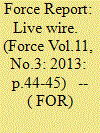

|
|
|
|
|
| Publication |
2013.
|
| Summary/Abstract |
After a long peace since the ceasefire came into being on 26 November 2003, the International Border (IB) in Jammu witnessed numerous ceasefire violations in 2013. Unlike the Line of Control (LC) which has seen innumerable ceasefire violations each year, with as many as 250 in 2013 alone, the IB getting live was unusual. The firings intensified since August causing loss of lives and property to civilians, who unlike the LC, live close to the IB. This unexpected activity got the Jammu and Kashmir chief minister, Omar Abdullah, to say that India should exercise options to silence Pakistani firing. Matters, however, finally settled on the IB with the recent meeting of the Border Security Force (BSF) and its counterpart, the Pakistani Chhamb rangers in R.S Pura sector. At sector commanders' level, both the sides agreed to maintain ceasefire and restore issues through negotiations.
|
|
|
|
|
|
|
|
|
|
|
|
|
|
|
|
| 5 |
ID:
124871
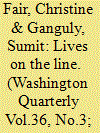

|
|
|
|
|
| Publication |
2013.
|
| Summary/Abstract |
The January 2013 clash in Kashmir emphasizes the need for a radical new approach: the United States should take the lead in changing the formal status of the Line of Control from a temporary boundary to a legally recognized international border.
|
|
|
|
|
|
|
|
|
|
|
|
|
|
|
|
| 6 |
ID:
124680
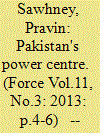

|
|
|
|
|
| Publication |
2013.
|
| Summary/Abstract |
In his years as COAS, General Ashfaq Pravez Kayani has by default done some good to the bilateral relationship.
|
|
|
|
|
|
|
|
|
|
|
|
|
|
|
|
| 7 |
ID:
124686
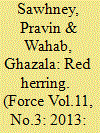

|
|
|
|
|
| Publication |
2013.
|
| Summary/Abstract |
It was making a mountain out of a molehill. Both the army and the media were complicit in this: One deliberately and the other out of ignorance. The recent anti-infiltration operations in Keran sector, which were declared over after two weeks on October 8 by the chief of army staff, General Bikram Singh in Delhi and the northern army commander, Lt General Sanjiv Chachra in Srinagar, were nothing more than a molehill.
Given such high profile army visitations, the media also decided to up the ante by searching for ghosts that did not exist. Did Pakistani soldiers intrude and occupy Indian posts across the Line of Control (LC)? Was another Kargil being replayed in Keran? Was the Indian Air Force using gunships to dislodge terrorists? Were recent talks between Prime Ministers Manmohan Singh and Nawaz Sharif in New York, which sought meetings between the two director general military operations (DGMOs), up in smoke? An English television channel (NDTV) even showed meeting with injured soldiers in Srinagar hospital as exclusive news.
|
|
|
|
|
|
|
|
|
|
|
|
|
|
|
|
| 8 |
ID:
128516
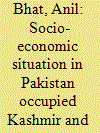

|
|
|
|
|
| Publication |
2013.
|
| Summary/Abstract |
in 1947 the combined population of Pak-occupied Kashmir (POK) and the 'Northern Areas" of Gilgit and Baltistan was 25 percent of the total population of ]&K State. Today this percentage has gone upto 33 percent of the total population of ]&K. The per decade growth rate of the population on both sides of the Line of Control (LoC) has remained the same. The steep rise in population in POK is because of the heavy in?ux of Punjabi Muslims from the plains. Today the Punjabi Muslims outnumber the Kashmiris in POK by a ratio of 5:1. Not only is 'Azad Kashmir' not Azad (free) - it hardly remains Kashmir except in name. Taking a cue from what the Chinese did in Tibet - the Pakistani Army has followed suit in POK - it has flooded the area with Punjabi Muslims to outnumber the Kashmiris in their own land. Most of the new Punjabi Muslim settlers were former soldiers of the Pakistani Army sent on a simple mission -
colonise Pakistan Occupied Kashmir, stamp out its Kashmiri identity all together, make it 'Pak' (which in Urdu means pure) by making it fully Punjabi. The grass always looks greener on the other side of the hill. It is a great tragedy that the strident propaganda of the jihadis has created a smoke screen that obfuscates the simple truth. Today we need to look across the LoC to see what is the reality. Not only is 'Azad Kashmir' no longer Kashmiri anymore in terms of demographic numbers, it never really was 'Azad' or free. In 1991, POK Prime Minister, Mumtaz Rathore was dismissed, arrested and flown by helicopter to a Pakistani prison.
|
|
|
|
|
|
|
|
|
|
|
|
|
|
|
|
| 9 |
ID:
124690
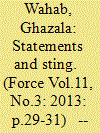

|
|
|
|
|
| Publication |
2013.
|
| Summary/Abstract |
That as a nation we are obsessed with ground-based tactics was in ample evidence at the annual press conference of the chief of air staff (CAS) Air Chief Marshal NAK Browne. A week before the 81st Indian Air Force day celebrations, the CAS and his staff had probably burnt the midnight oil to take on some hard-hitting questions from the media on the receding possibility of signing the ambitious Rafale fighter deal; depleting force levels; poor state of Indian Air Force (IAF) ground infrastructure, especially in remote border areas; allegations of nepotism on certain contracts and corruption on others; slow pace of modernisation of air defence assets; IAF's obstinacy on reforms in higher defence management; and inadequacy of ideas on creating a cogent deterrence for the threat from the east. Not once during their midnight confabulations would they have imagined, that all these efforts would come to a nought.
Because very few in the assembled gathering of the journalists wanted to ask the air force chief any question on the air force. Everyone wanted to know - repeatedly, question after question, in various combinations and permutations - about Indian Army's counter-infiltration (CI) operation in the Keran sector of north-west Kashmir. Kindled by exaggerations and fanned by rumours, the so-called CI operation in the thick forests of Keran was likened to the occupation of the Indian Army posts in the Kargil sector (northeast Kashmir), nearly 14 years ago. Even senior journalists, some with over 30 years of experience covering the Indian military, had started to write that a repeat of Kargil was underway with the Pakistan Army's irregulars having occupied the Indian territory.
|
|
|
|
|
|
|
|
|
|
|
|
|
|
|
|
|
|
|
|
|